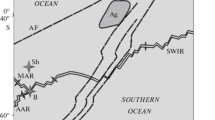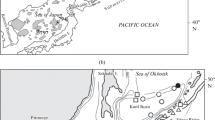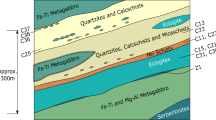Abstract
A model of the geological evolution of the Sea of Okhotsk is presented based on data from radioisotope age determinations and the mineral and isotope-geochemical composition of Late Mesozoic–Cenozoic volcanic rocks. We discuss the probable interrelationship between gas geochemical manifestations of gas fluxes with anomalous methane concentrations and the formation of gas hydrates, along with the occurrence of volcanic processes in the Sea of Okhotsk, fault zones, and different geological structures of basement and sedimentary deposits, landslides, and earthquakes. As a result of the studies, the nature of each volcanic stage has been determined. These include the Late Cretaceous continental-marginal belt stage (calc-alkaline), the Eocene transform-marginal (adakite) stage, and the Pliocene-Pleistocene island arc stage in the southern part of the Sea of Okhotsk. The sources of magma generation have been recognized, namely, the lithosphere subcontinental, asthenosphere oceanic, and plume-oceanic (OIB). The change in geodynamic regimens was traced back from the Late Cretaceous subduction regimen to the Maastrichtian–Datian transform-marginal, which continued as far as the Pliocene and ended at the resumption of the Pliocene–Pleistocene subduction of the Pacific Plate beneath the Eurasian continent. This involved the processes of destruction of the subduction plate, lithosphere and asthenosphere diapirism, and lower mantle plume upwelling. In the periods of geodynamic, seismotectonic and volcanic activities, gas migrated along the fault zones from the depth to the surface, together with different volcanic substrates ascending through the upper and lower mantle. Gas contained CO2, CH4, H2, He, N2, O2, and superheated steam (Н2О). Gas plays an important dynamic and physicochemical role in the evolution of the Sea of Okhotsk. At the present stage, gas fluxes migrating from the depth to the surface manifest as gas bubbles penetrating from the bottom sediments into the water column, with some portion of gas penetrating into the atmosphere. In the areas with gas fluxes, the fields containing anomalous concentrations of hydrocarbons, gas hydrate, carbon dioxide, hydrogen, and helium result in the formation of gas hydrates and associations of authigenic minerals and various geochemical elements.










Similar content being viewed by others
REFERENCES
G. P. Avdeiko, A. A. Palueva, and O. V. Kuvikas, “Adakites in the Circum Pacific subduction zones: review and analysis of geodynamic settings of their formation,” Vestn. KRAUNTs, No. 1, 45–60 (2011).
V. V. Akinin and E. L. Miller, “Evolution of calc-alkaline magmas of the Okhotsk–Chukotka volcanic belt,” Petrology 19 (3), 237–277 (2011).
Atlas: Geology and Mineral Resources of Russia’s Shelves, Ed. by M. N. Alekseeva (Nauch. mir, Moscow, 2004) [in Russian].
O. A. Bogatikov, V. I. Kovalenko, and E. V. Sharkov, Magmatism. Tectonics, and Geodynamics of the Earth: Spatiotemporal Relations (Nauka, Moscow, 2010) [in Russian].
T. A. Emelyanova and E. P. Lelikov, “The role of volcanism in the development of the Japan, Okhotsk, and Philippine marginal seas,” Petrology 18 (6), 624–645 (2010).
T. A. Emelyanova and E. P. Lelikov, “Volcanism as an indicator of a depth mechanism for the formation of the Seas of Japan and Okhotsk,” Russ. J. Pac. Geol. 7 (2), 124–132 (2013).
T. A. Emel’yanova and E. P. Lelikov, “Volcanism and the origin of the Sea of Japan and the Sea of Okhotsk as a response to development of the pacific superplume,” Dokl. Earth Sci. 456 (1), 517–519 (2014).
T. A. Emel’yanova and E. P. Lelikov, “Geochemistry and petrogenesis of the Late Mesozoic—Early Cenozoic volcanic rocks of the Okhotsk and Japan marinal seas,” Geochem. Int. 54 (6), 509–521 (2016).
B. Ya. Karp, “Structure of the crust of the Sea of Japan floor based on seismic data,” Geology and Mineral Resources of Russia’s Shelves, Ed. by M. N. Alekseeva (GEOS, Moscow, 2002) [in Russian].
S. A. Kasatkin and A. I. Obzhirov, “Fluid-controlling significance of the Nosappu fracture zone and conditions for the formation of methane fluxes and gas hydrates (Sea of Okhotsk Region),” Russ. J. Pac. Geol. 12 (1), 57–62 (2018).
V. I. Kovalenko, V. V. Yarmolyuk, and O. A. Bogatikov, “The recent supercontinent in the northern hemisphere of the Earth (North Pangea): magmatic and geodynamic evolution,” Dokl. Earth Sci. 427A (5), 897–901 (2009).
A. V. Koloskov, L. I. Gontovaya, and S. V. Popruzhenko, “The upper mantle of Kamchatka in isotopic–geochemical and geophysical anomalies: the role of asthenospheric diapirism,” Russ. J. Pac. Geol. 8 (3), 151–162 (2014).
M. I. Kuz’min, V. V. Yarmolyuk, and V. A. Krav-chinskii, “Absolute paleogeographic reconstructions of the Siberian Craton in the Phanerozoic: a problem of time estimation of superplumes,” Dokl. Earth Sci. 437 (1), 311–315 (2011).
R. G. Kulinich, M. G. Valitov, S. M. Nikolaev, and T. N. Kolpashchikova, “Moho’s discontinuity topography and types of the Earh’s crust on the northwestern Sea of Japan: gravity data, Russian Far East Sea, Ed. by V. A. Akulichev (Nauka, Moscow, 2007), No. 3, pp. 48–53 [in Russian].
E. P. Lelikov, Metamorphic Complexes of the Pacific Marginal Seas (DVO AN SSSR, Vladivostok, 1992) [in Russian].
E. P. Lelikov and A. N. Malyarenko, Granitoid Magmatism of the Pacific Marginal Seas (Dal’nauka, Vladivostok, 1994) [in Russian].
F. R. Likht, “Transit linear morphostructures in the TPP geomorphological space as exemplified by the Sea of Japan lineament,” Structural Features and Evolution of Geospheres. Proc. 4th International Conf., Khabarovsk, Russia,1998 (DVO RAN, Khabarovsk, 1998), pp. 28–31 [in Russian].
Yu. A. Martynov, A. A. Chashchin, V. P. Simanenko, and A. Yu. Martynov, “Maestrichtian–Danian andesite series of the Eastern Sikhote Alin: mineralogy, geochemistry, and petrogenetic aspects,” Petrology 15 (3), 275–295 (2007).
Yu. A. Martynov, Principles of Magmatic Geochemistry (Dal’nauka, Vladivostok, 2010) [in Russian].
Yu. A. Martynov and A. I. Khanchuk, “Cenozoic volcanism of the eastern Sikhote Alin: petrological studies and outlooks,” Petrology 21 (1), 85—100 (2013).
Methane Monitoring in the Sea of Okhotsk, Ed. by A. I. Obzhirov, A. N. Salyuk, and O. F. Vereshchagina (Dal’nauka, Vladivostok, 2002) [in Russian].
A. I. Obzhirov, B. A. Kazanskii, and Yu. I. Mel’nichenko, “Effect of voice scattering by natural water in the marginal parts of the Sea of Okhotsk,” Tikhookean. Geol., No. 2, 119–121 (1989).
A. I. Obzhirov, Gas-Geochemical Fields of Natural Layer of Sea and Oceans (Nauka, Moscow, 1993) [in Russian].
A. G. Rodnikov and L. P. Zabarinskaya, V. B. Piip, V. A. Rashidov, N. A. Sergeeva, and N. I. Filatova, “Geotraverse of the Sea of Okhotsk region,” Vestn. KRAUNTs. Ser. Nauki Zemle, No. 5, 45–58 (2005).
V. P. Simanenko, V. V. Golozubov, and V. G. Sakhno, “Geochemistry of volcanic rocks from transform margins: evidence from the Alchan Basin, Northwestern Primorie,” Geochem. Int. 44 (12), 1157–1169 (2006).
I. A. Tararin, “Geological structure and models of formation of the deep-water Kurile basin of the Sea of Okhotsk,” in Pacific Ore Belt: New Data (Dal’nauka, Vladivostok, 2008), pp. 308–321 [in Russian].
Tectonics and Hydrocarbon Potential of the Sea of Okhotsk, Ed. by O. V. Veselov, E. V. Gretskaya, A. Ya. Il’ev (Nauka, Moscow, 2006) [in Russian].
N. I. Filatova, “Dynamics of the Marginal-Sea Magmatism (Korean—Japan region),” Litosfera, No. 3, 33–56 (2004).
V. Yu. Chevychelov, G. P. Zaraiskii, S. E. Borisovskii, and D. A. Borkov, “Effect of melt composition and temperature on the partitioning of Ta, Nb, Mn, and F between granitic (alkaline) melt and fluorine-bearing aqueous fluid: fractionation of Ta and Nb and conditions of ore formation in rare-metal granites,” Petrology 13 (4), 305–321 (2005).
B. V. Baranov, Y. K. Jin, H. Shoji, et al., “Gas hydrate system of the Sakhalin slope: geophysical approach,” Scientific Report of the Sakhalin Slope Gas Hydrate Project (2007).
K. C. Condie, “Incompatible element ratios in oceanic basalts and komatiites: tracking deep mantle sources and continental growth rates with time,” Geochem., Geophys., Geosyst. 4 (1), 1–18 (2003).
M. J. Defant, and M. S. Drummond, “St. Helens Mount: potential example of the partial melting of the subducted lithosphere in a volcanic arc,” Geology 21, 547–550 (1993).
T. A. Emel’yanova, E. P. Lelikov, and V. T. S’edin, “Geochemical features of the Okhotsk sea Cenozoic Volcanism,” J. Geo-Mar. Lett. 26 (5), 275–286 (2006).
B. S. Kamber and K. D. Collerson, “Role of ‘hidden’ deeply subducted slabs in mantle depletion,” Chem. Geol. 166, 241–254 (2000).
H. Minami, K. Tatsumi, A. Hachikubo, S. Yamashita, H. Sakagami, N. Takahashi, H. Shoji, Y. K. Jin, A. Obzhirov, N. Nikolaeva, and A. Derkachev, “Possible variation in methane flux caused by gas hydrate formation on the northeastern continental slope off Sakhalin Island, Russia,” Geo-Mar. Lett. 32 (5), 525–534 (2012).
C. Munker, G. Worner, G. Yogodzinsky, and T. Churikova, “Behaviour of high field strength elements in subduction zone: constraints from Kamchatka-Aleution Arc lavas,” Earth Planet. Sci. Lett. 224, 275–293 (2004). https://doi.org/10.1016/j.epsl.2004.05.030
A. Obzhirov, R. Shakirov, A. Salyuk, E. Suess, N. Biebow, and A. Salomatin, “Relations between methane venting, geological structure and seismo-tectonics in the Sea of Okhotsk,” GeoMar. Lett. 24 (3), 135–139 (2004). https://doi.org/10.1007/s00367-004-0175-0
L. N. Propp, A. I. Obzhirov, and M. V. Propp, “Gas anomalies and hydrochemical anomalies in bottom water in an area of volcanic activity (Bay of Plenty, New Zealand),” Oceanology 32 (4), 463–468 (1992). https://doi.org/10.1594/PANGAEA.759281
I. W. Shervais, “Ti–V plots and petrogenesis of modern and ohpiolitic lavas,” Earth. Planet. Sci. Lett. 59 (1), 101–118 (1982). https://doi.org/0012-821 X/82/0000-0000/$02.75
R. N. Thompson, “Dispatches from Tertiary volcanic province,” Scot. J. Geol. 18, 49–107 (1982).
Funding
The study was performed in accordance with the Fundamental Research Program of the Pacific Oceanological Institute of the Far East Branch, Russian Academy of Sciences (POI FEB RAS) theme no. 0271-2019-0006 (no. on the State Registration AAAA-A17-117030110035-4), FWMM-2019-0006 (no. on the State Registration АААА-А19-119122090009-2) and theme no. 0271-2019-0005 (no. on the State Registration АААА-А17-117030110033-0). The study was supported partly by the Russian Foundation for Basic Research (project no. 20-55-50005).
Author information
Authors and Affiliations
Corresponding author
Additional information
Recommended for publishing by G.L. Kirillova
Translated by N. Kovriga
Rights and permissions
About this article
Cite this article
Obzhirov, A., Emelyanova, T., Telegin, Y. et al. Gas Flows in the Sea of Okhotsk Resulting from Cretaceous-Cenozoic Tectonomagmatic Activity. Russ. J. of Pac. Geol. 14, 156–168 (2020). https://doi.org/10.1134/S1819714020020049
Received:
Revised:
Accepted:
Published:
Issue Date:
DOI: https://doi.org/10.1134/S1819714020020049




